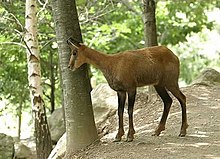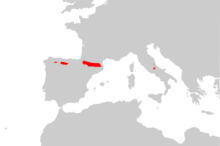Pyrenean chamois: Difference between revisions
No edit summary |
m Moving Category:Habitats Directive Species to Category:Habitats Directive species per Wikipedia:Categories for discussion/Log/2024 April 27#Category:Habitats Directive Species |
||
| (19 intermediate revisions by 14 users not shown) | |||
| Line 1: | Line 1: | ||
{{Short description|Species of mammal}} |
|||
{{Speciesbox |
{{Speciesbox |
||
| name = Pyrenean chamois |
| name = Pyrenean chamois |
||
| status = LC |
| status = LC |
||
| status_system = IUCN3.1 |
| status_system = IUCN3.1 |
||
| status_ref = <ref name=iucn>{{cite iucn |title=''Rupicapra pyrenaica'' |author=Herrero, J. |author2=Lovari, S. |author3=Nores, C. |author4=Toigo, C. |date=2022|page=e.T19771A217715455|doi=10.2305/IUCN.UK.2022-1.RLTS.T19771A217715455.en|access-date=21 July 2022}}</ref> |
|||
| status_ref = <ref>https://www.iucnredlist.org/species/19771/171131310</ref> |
|||
| image = Isard des pyrenees bigorre 2003.jpg |
| image = Isard des pyrenees bigorre 2003.jpg |
||
| taxon = Rupicapra pyrenaica |
| taxon = Rupicapra pyrenaica |
||
| authority = ([[Charles Lucien Bonaparte|Bonaparte]], 1845) |
| authority = ([[Charles Lucien Bonaparte|Bonaparte]], 1845) |
||
| range_map = |
| range_map = Rupicapra pyrenaica range Map.png |
||
| range_map_caption = |
| range_map_caption = Distribution of Pyrenean chamois |
||
}} |
}} |
||
The '''Pyrenean chamois''' (''Rupicapra pyrenaica'') is a [[goat-antelope]] that lives in the [[Pyrenees]] |
The '''Pyrenean chamois''' ('''''Rupicapra pyrenaica''''') is a [[goat-antelope]] that lives in the [[Pyrenees]] and [[Cantabrian Mountains]] of [[Spain]], [[France]] and [[Andorra]], and the [[Apennine Mountains]] of central [[Italy]]. It is one of the two species of the genus ''Rupicapra'', the other being the [[chamois]], ''Rupicapra rupicapra''.<ref name=iucn /> |
||
==Names== |
==Names== |
||
*[[Spanish language|Spanish]]: ''rebeco'', ''gamuza'' |
*[[Spanish language|Spanish]]: ''rebeco'', ''gamuza'' |
||
*[[French language|French]]: ''izard/isard'' |
*[[French language|French]]: ''izard/isard'' |
||
*[[ |
*[[Galician language|Galician]]: ''rebezo'' |
||
*[[Asturian language|Asturian]]: ''robecu/robezu'' |
|||
*[[Catalan language|Catalan]]: ''isard'' |
*[[Catalan language|Catalan]]: ''isard'' |
||
*[[Italian language|Italian]]: ''camoscio dei Pirenei'', ''camoscio appenninico'' |
*[[Italian language|Italian]]: ''camoscio dei Pirenei'', ''camoscio appenninico'' |
||
*[[Basque language|Basque]]: ''pirinioetako sarrioa'' |
*[[Basque language|Basque]]: ''pirinioetako sarrioa'' |
||
*[[Aragonese language|Aragonese]]: ''sarrio'', ''chizardo'' |
*[[Aragonese language|Aragonese]]: ''sarrio'', ''chizardo'' |
||
| ⚫ | |||
{| class="wikitable" |
|||
|- |
|||
! Image !! Subspecies !! Distribution |
|||
|- |
|||
| ⚫ | |||
|- |
|||
| ⚫ | |||
|- |
|||
| ⚫ | |||
|- |
|||
|} |
|||
==Description== |
==Description== |
||
| Line 26: | Line 42: | ||
==Conservation== |
==Conservation== |
||
Like other species of chamois, it was hunted almost to [[extinction]], especially in the 1940s, for the production of [[chamois leather]]. The population has since recovered, and in |
Like other species of chamois, it was hunted almost to [[extinction]], especially in the 1940s, for the production of [[chamois leather]]. The population has since recovered, and in 2022 was estimated to be about 50,000 mature individuals.<ref>Pérez-Barbería, F. J., García-González, R. (2004). [https://web.archive.org/web/20051229232203/http://www.vertebradosibericos.org/mamiferos/pdf/ruppyr.pdf "Rebeco – Rupicapra pyrenaica."] Enciclopedia Virtual de los Vertebrados Españoles. Carrascal, L. M., Salvador, A. (Eds.). Museo Nacional de Ciencias Naturales. Madrid, Spain.</ref><ref name=iucn /> |
||
| ⚫ | |||
[[File:Rupicapra pyrenaica ornata 5.JPG|''Rupicapra pyrenaica ornata''|left|thumb|200px]] |
|||
| ⚫ | |||
| ⚫ | |||
| ⚫ | |||
{{Clear|left}} |
{{Clear|left}} |
||
| Line 38: | Line 48: | ||
==References== |
==References== |
||
{{Reflist}} |
{{Reflist}} |
||
* Haack, M. 2002. [http://animaldiversity.ummz.umich.edu/site/accounts/information/Rupicapra_pyrenaica.html ''Rupicapra pyrenaica'']. Animal Diversity Web. Accessed February 20, 2006. |
* Haack, M. 2002. [http://animaldiversity.ummz.umich.edu/site/accounts/information/Rupicapra_pyrenaica.html ''Rupicapra pyrenaica'']. Animal Diversity Web. Accessed February 20, 2006. |
||
* Pérez, T., Albornoz, J. & Domínguez, A. (2002). Phylogeography of chamois (Rupicapra spp.) inferred from microsatellites. Mol Phylogenet Evol. 25, 524–534. |
* Pérez, T., Albornoz, J. & Domínguez, A. (2002). Phylogeography of chamois (Rupicapra spp.) inferred from microsatellites. Mol Phylogenet Evol. 25, 524–534. |
||
* Pérez-Barbería, F. J., García-González, R. (2004). [https://web.archive.org/web/20051229232203/http://www.vertebradosibericos.org/mamiferos/pdf/ruppyr.pdf "Rebeco – Rupicapra pyrenaica."] Enciclopedia Virtual de los Vertebrados Españoles. Carrascal, L. M., Salvador, A. (Eds.). Museo Nacional de Ciencias Naturales. Madrid, Spain. |
|||
{{Artiodactyla|R.3}} |
{{Artiodactyla|R.3}} |
||
{{Taxonbar|from=Q902896}} |
{{Taxonbar|from=Q902896}} |
||
| Line 50: | Line 59: | ||
[[Category:Mammals described in 1845]] |
[[Category:Mammals described in 1845]] |
||
[[Category:Taxa named by Charles Lucien Bonaparte]] |
[[Category:Taxa named by Charles Lucien Bonaparte]] |
||
[[Category:Habitats Directive species]] |
|||
Latest revision as of 22:09, 5 May 2024
| Pyrenean chamois | |
|---|---|

| |
| Scientific classification | |
| Domain: | Eukaryota |
| Kingdom: | Animalia |
| Phylum: | Chordata |
| Class: | Mammalia |
| Order: | Artiodactyla |
| Family: | Bovidae |
| Subfamily: | Caprinae |
| Tribe: | Caprini |
| Genus: | Rupicapra |
| Species: | R. pyrenaica
|
| Binomial name | |
| Rupicapra pyrenaica (Bonaparte, 1845)
| |

| |
| Distribution of Pyrenean chamois | |
The Pyrenean chamois (Rupicapra pyrenaica) is a goat-antelope that lives in the Pyrenees and Cantabrian Mountains of Spain, France and Andorra, and the Apennine Mountains of central Italy. It is one of the two species of the genus Rupicapra, the other being the chamois, Rupicapra rupicapra.[1]
Names
[edit]- Spanish: rebeco, gamuza
- French: izard/isard
- Galician: rebezo
- Asturian: robecu/robezu
- Catalan: isard
- Italian: camoscio dei Pirenei, camoscio appenninico
- Basque: pirinioetako sarrioa
- Aragonese: sarrio, chizardo
Subspecies
[edit]| Image | Subspecies | Distribution |
|---|---|---|
 |
R. p. pyrenaica (Pyrenean chamois) | France and Spain |
 |
R. p. parva (Cantabrian chamois) | Spanien |
 |
R. p. ornata (Abruzzo chamois) | Central and southern Italy |
Description
[edit]Up to 80 cm tall, its summer coat is a ruddy brown; in winter, it is black or brown, with darker patches around the eyes. Both males and females have backward-hooked horns up to 20 cm in length. They browse on grass, lichens and buds of trees. Sure-footed and agile, they are found on any elevation up to 3000 m.
Conservation
[edit]Like other species of chamois, it was hunted almost to extinction, especially in the 1940s, for the production of chamois leather. The population has since recovered, and in 2022 was estimated to be about 50,000 mature individuals.[2][1]
References
[edit]- ^ a b c Herrero, J.; Lovari, S.; Nores, C.; Toigo, C. (2022). "Rupicapra pyrenaica". IUCN Red List of Threatened Species. 2022: e.T19771A217715455. doi:10.2305/IUCN.UK.2022-1.RLTS.T19771A217715455.en. Retrieved 21 July 2022.
- ^ Pérez-Barbería, F. J., García-González, R. (2004). "Rebeco – Rupicapra pyrenaica." Enciclopedia Virtual de los Vertebrados Españoles. Carrascal, L. M., Salvador, A. (Eds.). Museo Nacional de Ciencias Naturales. Madrid, Spain.
- Haack, M. 2002. Rupicapra pyrenaica. Animal Diversity Web. Accessed February 20, 2006.
- Pérez, T., Albornoz, J. & Domínguez, A. (2002). Phylogeography of chamois (Rupicapra spp.) inferred from microsatellites. Mol Phylogenet Evol. 25, 524–534.

